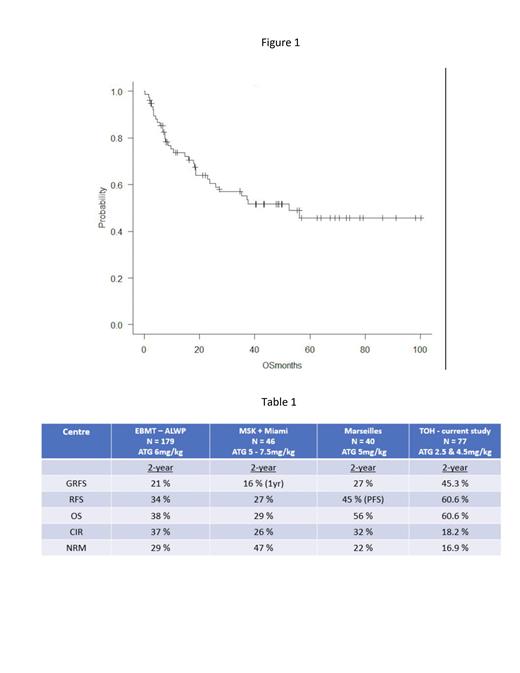DISCUSSION
INTRODUCTION
Anti thymocyte globulin (ATG) based Graft versus Host disease (GVHD) prophylaxis is widely used for unrelated donor allogeneic hematopoietic cell transplantation (HCT) although the optimal dose remains unclear. Recently, registry based and single centre retrospective analyses have suggested superior outcomes with the PTCy based GVHD prophylaxis regimens when compared to ATG based regimens in mismatched unrelated donor (MMUD) allogeneic HCT, however, these studies all used doses of ATG ≥ 5mg/kg. Outcomes following MMUD allogeneic HCT with lower dose ATG based GVHD prophylaxis regimens have not been extensively studied. Thus, we analysed outcomes of HLA 9/10 MMUD allogeneic HCTs using two low dose ATG based regimens as GVHD prophylaxis at our centre.
All adult patients undergoing standard of care allogenic hematopoietic cell transplant at The Ottawa Hospital from January 1 st 2015- December 31, 2022 were included. Data regarding demographics, HLA mismatched allele, conditioning regimen, dose of ATG, time to engraftment, and rates of acute and chronic GVHD was collected. The primary outcome evaluated was overall survival (OS) and secondary outcomes were GVHD-free relapse-free survival (GRFS), cumulative incidence of relapse (CIR) and non-relapse mortality (NRM). Survival outcomes were analyzed using Kaplan Meier analysis. Predictors of survival were identified using Cox-proportional hazards regression model.
77 patients (Males 62.3% (n=48); Median age - 50 years) underwent allogeneic HCT from MMUD. Most common indication for transplant was MDS/AML in 66.2% (n=51) followed by ALL in 11.3% (n=9) patients. Most frequently mismatched locus was HLA A in 37.7% (n= 29) followed by HLA B in 14.3% (n=11). Myeloablative conditioning regimen was received by 76.6% (n=59) while reduced intensity regimens were used in 23.4% (n=18) patients. Rabbit ATG was part of the GVHD prophylaxis regimen in all patients with majority (81%; n=63) receiving 2.5mg/kg and remaining 18.2% (n=14) receiving 4.5mg/kg of the drug. Grade II-IV acute GVHD occurred in 24.7% (n=19) while chronic GVHD occurred in 32.5% (n= 25) patients. After a median follow up of 21 months, relapse occurred in 28.6% (n=22) patients. Two year OS (Fig 1), and GRFS of the whole cohort were 60.6% and 45.3% respectively. 2-year incidence of non-relapse mortality (NRM) and cumulative incidence of relapse (CIR) were 16.9% and 18.2% respectively. Dose of ATG (2.5 mg/kg vs 4.5 mg/kg) was not a predictor of outcomes in either univariate and multivariate analyses. Age more than 50 years, primary diagnosis of lymphoma, reduced intensity conditioning and mismatch in loci other than HLA C were significant predictors of poor OS after univariate analysis. Only primary diagnosis of lymphoma (Hazard Ratio (HR) - 7.76; p=0.045) and mismatch in loci other than HLA C (HR - 9.53; p=0.03) were significant predictors of poor OS after multivariate analysis. When compared to published single centre and registry-based studies using ATG doses ≥ 5 mg/kg, GVHD prophylaxis using ATG doses ≤4.5 mg/kg seems to provide improved outcomes in patients undergoing allogeneic HCT from mismatched unrelated donors (Table 1).
Our findings suggest that further studies are needed directly comparing lower dose ATG based regimens to PTCy based regimens to determine the ideal GVHD prophylaxis regimen for patients undergoing allogeneic HCT from HLA mismatched unrelated donors.
Disclosures
No relevant conflicts of interest to declare.


This feature is available to Subscribers Only
Sign In or Create an Account Close Modal